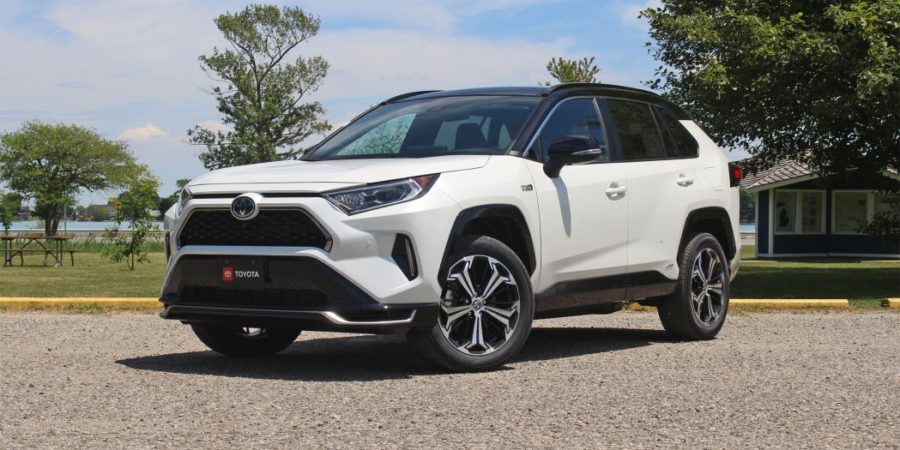Cars that can talk to each other, self-driving cars and augmented reality visual aids are just a few of the innovative automotive trends to look forward to in 2017 and beyond. Best of all, some of these technologies can be found in new-model cars sitting in showrooms across the country, while others will be rolling off the assembly lines within the next couple of years. Here are six of the most exciting trends for 2017 and beyond.
So far, there haven’t been many hybrid variants of smaller mainstream two-row crossovers and, understandably, all have focused on efficiency. The new, range-topping 2021 Toyota RAV4 Prime is flipping the script.
For 2021, Toyota is looking to reclaim the performance high ground in the compact crossover segment with a plug-in hybrid. The RAV4 Prime may approach performance from a completely different angle, but 302 horsepower is 302 horsepower, and quick is quick. Like our Volvo S60 long-termer, the 2021 RAV4 Prime is poised to be as fun as it is frugal.
1. Conversational Cars
Cars operated by voice command are already in the works, with Ford announcing plans to integrate Amazon’s Echo platform into upcoming models. By 2020, however, cars will be able to digitally talk to each other. Cadillac’s CTS sports sedans already are being implemented with vehicle-to-vehicle (V2V) communication, which enables them to share information with other drivers about driving conditions, accidents, weather and other road safety issues.
2. Augmented Reality
Augmented Reality (AR) isn’t just for video games anymore. During the next few years, AR features will include heads-up displays such as directional arrows superimposed on the road ahead (guided by GPS routing systems). AR can also provide visualized solutions for mechanics, thus speeding up what could be a lengthy repair job. As cars become more connected, AR will be even more fully integrated into the driving experience.
3. Self-Driving Cars with Artificial Intelligence
With the debut of the Super Cruise feature on Cadillac’s CT6 sedan, self-driving cars are now a reality. Controlled by a semi-autonomous system, Cadillac’s Super Cruise system also has an eye-tracking system that audibly and visually prompts drivers who aren’t paying attention. Audi, Tesla, Mercedes-Benz, Toyota and Honda are also following suit, with a variety of AI-powered models expected to appear in showrooms between now and 2020.
4. Enhanced Safety Features
Thanks to cutting-edge technology becoming more mainstream, high-end security systems, formerly the province of luxury cars, are now being implemented in lower- and mid-priced cars. For instance, Toyota’s Star Safety system, a suite of six advanced safety
features (including anti-lock brakes, brake control and vehicle stability control) is now being implemented in every Toyota, including its bargain Yaris model. Likewise, Volvo has announced that it’s implementing more secure welding techniques in order to produce stronger, more resistant car frames.
In addition, the same cyber security technologies used to combat computer viruses are now being implemented in dashboards to protect data stored in cars, so your information will stay just as safe and secure as it is in your laptop or desktop.
5. Parking Apps and Smart Lighting
Thanks to advanced connectivity, automotive manufacturers are getting even closer to their goal of producing a fully-automated car. In 2017, both Mercedes-Benz and BMW hope to introduce a parking app that enables drivers to park cars remotely using their smartphones. Likewise, manufacturers are developing smart headlights that will dim automatically when other cars are approaching. Volvo is taking this a step further, with plans to produce headlights that swivel along with every turn of the wheel to provide better visibility.
6. Hatchbacks and Crossovers
To accommodate today’s changing tastes, car manufacturers are gradually revamping the traditional SUV into a new style of hatchback crossover vehicle, which offers all the convenience of extra cargo room without taking up so much road space and fuel. Last year, Americans bought 5.6 million of these crossover types — a number that reflects almost a third of new car sales. Popular crossovers include the Honda CR-V and Toyota RAV4, and this year’s new additions include the Nissan Rogue Sport, the Mazda CX-5 and the Ford EcoSport, as well as a streamlined version of the GMC Terrain. According to manufacturers, the trend will continue with more crossovers hitting the market soon.
These innovations are being implemented quickly so that within a year or two, consumers will start finding used cars on the market with these same cutting-edge technologies. Within the next several years, automotive makers may well reach their goal of producing a fully connected car controlled entirely by artificial intelligence.
Lorem ipsum dolor sit amet, consectetur adipiscing elit, sed do eiusmod tempor incididunt ut labore et dolore magna aliqua. Vestibulum lorem sed risus ultricies tristique nulla. Sem viverra aliquet eget sit amet tellus cras adipiscing. Varius sit amet mattis vulputate enim nulla. Elit ullamcorper dignissim cras tincidunt. Convallis aenean et tortor at risus viverra adipiscing at int.




